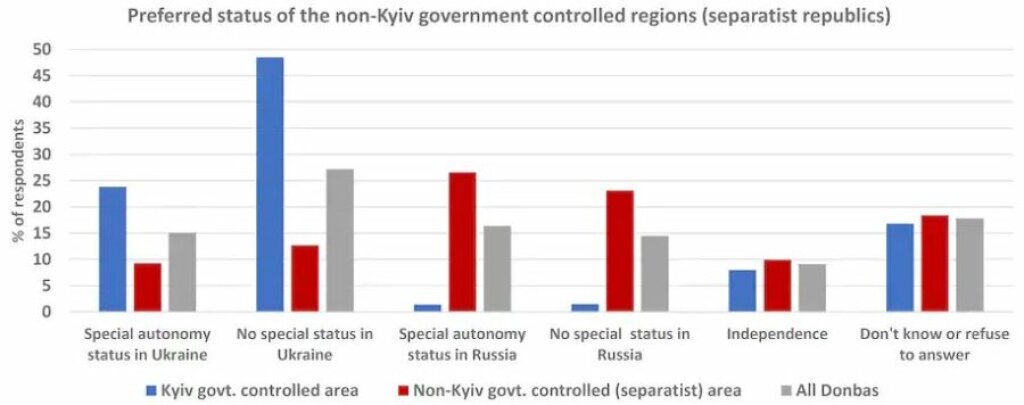The Jordan Center stands with all the people of Ukraine, Russia, and the rest of the world who oppose the Russian invasion of Ukraine. See our statement here.
This article originally appeared on Monkey Cage on 4/15/2022.
John O’Loughlin, professor of distinction at the University of Colorado at Boulder, is a political geographer with research interests in the human outcomes of climate change in sub-Saharan Africa and in the geopolitical orientations of people in post-Soviet states.
Gerard Toal, professor in the School of Public and International Affairs at Virginia Tech’s campus in Arlington, Va., is the author of “Near Abroad: Putin, the West and the Contest for Ukraine and the Caucasus” (Oxford University Press, 2017).
Gwendolyn Sasse is director of the Center for East European and International Studies (ZOiS), professor in the department of social sciences at Humboldt University of Berlin and senior research fellow at the University of Oxford’s Nuffield College. She researches the dynamics of war, identities, protest and migration and is involved in survey projects in Ukraine, Russia and Belarus.
The authors acknowledge funding for this work from the National Science Foundation and from ZOiS (Center for East European and International Studies), Berlin. The survey protocol was approved by the University of Colorado Human Subjects board.
We surveyed people in Ukraine’s contested eastern region to see what they wanted. Here’s what we found.
The war in Ukraine is officially in its second month. But Russia’s attack on Ukraine’s territory began in 2014. That’s when Russia unilaterally annexed Crimea and intervened to prop up separatists who sought to create Russian proxy states in part of what’s called “the Donbas,” Ukraine’s two easternmost regions of Luhansk and Donetsk, which border Russia. Ukraine has been fighting against these proxy states since. Russian President Vladimir Putin provocatively escalated that conflict right before the latest invasion, declaring in February that Russia would recognize these entities — the Donetsk Peoples Republic (DNR) and the Luhansk Peoples Republic (LNR) — as independent states, including supporting their claim to all the territory of the Donbas.
The Russian military has announced a new war strategy, focusing “on the main goal, the liberation of the Donbas.” But do ordinary people living in the Donbas actually want what “liberation” probably means: violent conquest, followed by independence or annexation to Russia?
Our research just before the February invasion suggests some answers.
How we did our research
In January, we conducted a large, computer-assisted telephone public opinion survey of people living in the two regions on both sides of the military line of contact. To enable cross-checking of the survey data, we used three companies: the U.K.-based agency R-Research and the Kyiv International Institute of Sociology calling from Ukraine, and Levada Marketing Research calling from Russia. In total, 4,025 people were interviewed, with equal numbers on both sides of the line of contact dividing the Donbas. Data are weighted proportional to current population estimations separately in the Kyiv-controlled and separatist areas.
The opinions of those forcibly displaced are thus absent. Estimates are that up to 3 million of the 6.5 million people who lived in the Donbas region in early 2014 had left by early 2022, with many more fleeing since the invasion began in February.
What do the people of Donbas want?
Because of the fiercely contested nature of the Russian proxy “republics” in Ukraine, when asking people what status they preferred for the region, it proved impossible to use the same wording on both sides of the Donbas divide. In the areas controlled by the Ukrainian government, respondents were asked: “In your opinion, what should be the status of the regions of the Donbas temporarily uncontrolled by the Kyiv government”? In the separatist-held areas, the question ended, “…of the Donetsk Peoples Republic (DNR)/Luhansk Peoples Republic (LNR).” Each respondent could choose from five answers, as you can see in the figure below.
When the responses are weighted by the estimated total population on either side of the line of control in the Donbas before the war (1.7 million in the Kyiv-controlled zone and 2.1 million in the separatist republics), more people preferred to remain in Ukraine (42 percent) than be annexed to Russia (31 percent). Just 9 percent opted for independence. For this sensitive question with a high degree of uncertainty about Kyiv’s and Moscow’s actions, the “don’t know” ratio is high at 18 percent.
But the figure in which we averaged data from all the survey firms summary data hides some big differences. While the Ukrainian and Russian pollsters found similar opinions in areas controlled by the Ukrainian government, in the breakaway area, pollsters calling from Russia found higher support (70 percent) for joining Donbas with Russia than did the pollsters calling from Ukraine (16 percent). (Some respondents may have decided whether to answer the call or participate in the survey according to whether it originated in Kyiv or Moscow, or may have replied with answers that they thought the interviewers wanted to hear.)
In the Ukrainian government-controlled areas, almost 3 in 4 respondents (72 percent) wanted the breakaway territories back within Ukraine. These residents were twice as likely to say the Donbas should not have any special status as to say it should have special autonomous status within Ukraine.
In the separatist-held areas, opinion was more splintered. Forty-nine percent said they wanted to be part of the Russian Federation, with a roughly equal proportion saying they wanted to be a special autonomous region or just an ordinary part of Russia. On both sides of the line of contact, fewer than 10 percent supported independence. Almost 1 in 5 respondents — on both sides of the line of control — said they did not know.
All this largely echoes our findings in an earlier survey in late 2020. In other words, beliefs about where the contested territory belongs were stable before Russia’s latest invasion.
Who will get to vote in upcoming status referendums?
Among Donbas residents, the debate is between those who want to be annexed by Russia and those who do not; the independence that the Kremlin recently recognized isn’t desired. Leaders of both the “Luhansk Peoples Republic” and the “Donetsk Peoples Republic” have declared that they will hold referendums on joining Russia, announcements possibly approved by the Kremlin.
These referendums are likely to be modeled on one held in Crimea in March 2014, in which pro-Ukrainian activists and journalists were detained while the local government aired Russian programming and citizens voted while Russian soldiers watched.
Our research suggests that in a free and fair referendum held throughout the Donbas — under international supervision and with impartial, transparent and inclusive voting rules that allowed those displaced since 2014 to vote — the majority would be likely to vote to remain in Ukraine. However, a vote restricted to just those remaining in the Donbas would be likely to endorse joining Russia. Either way, war has hardened attitudes, so any such referendum would be bitterly contentious.



